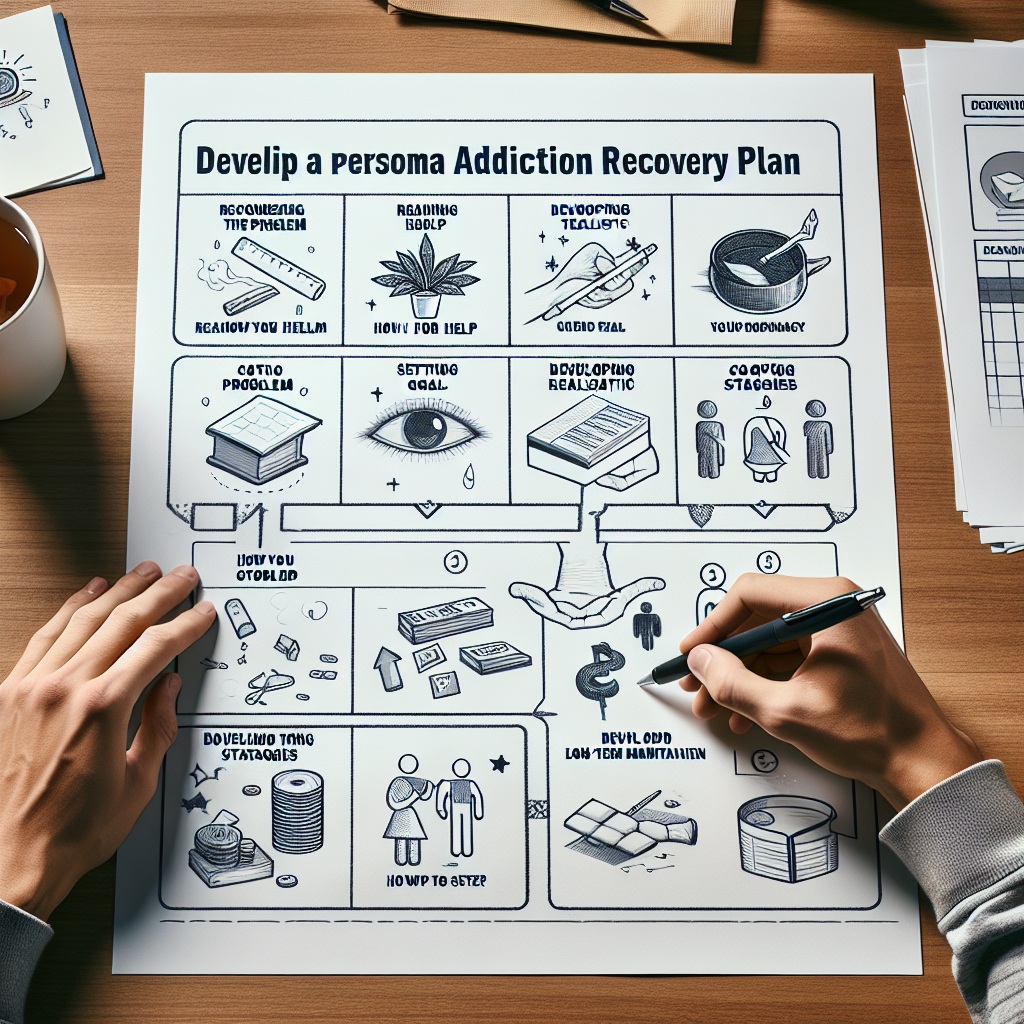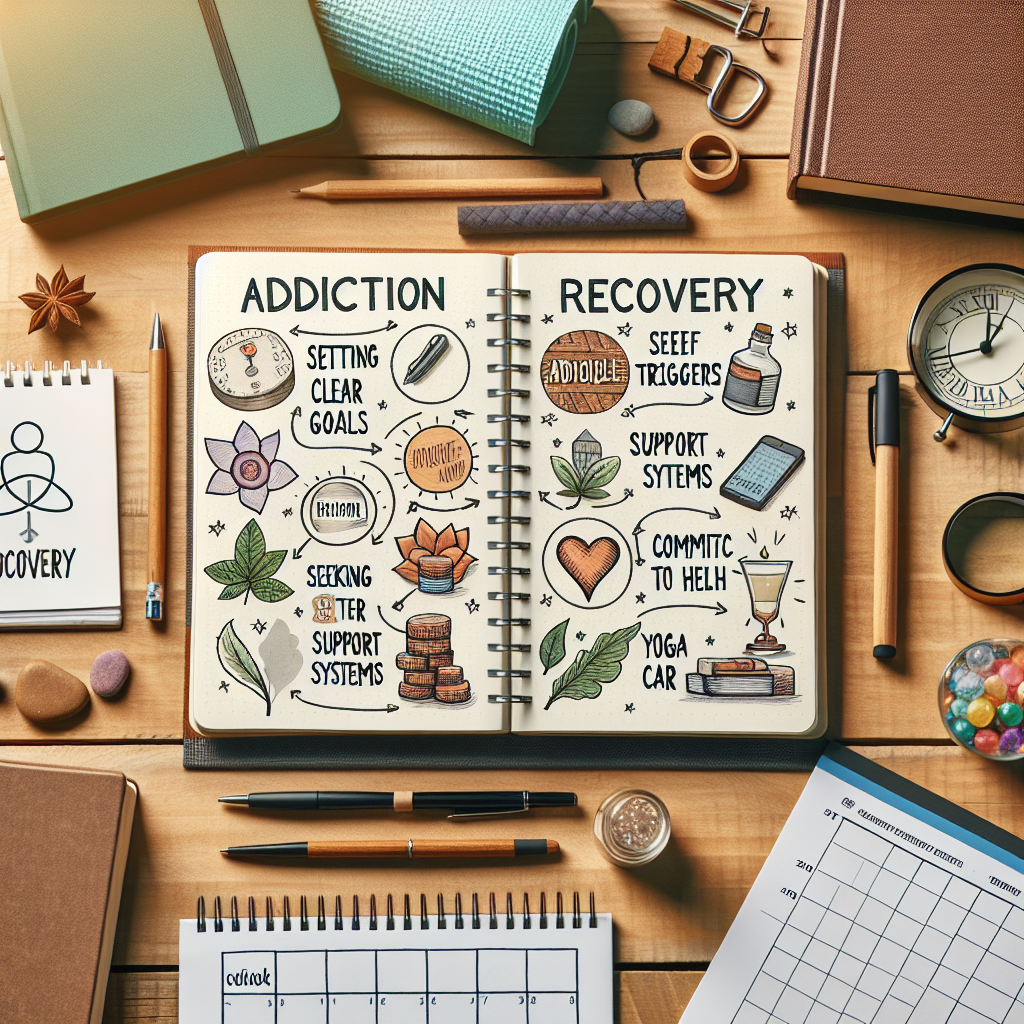-
Table of Contents

“Empower Your Journey: Crafting a Tailored Path to Addiction Recovery”
Introduction
Creating a personalized addiction recovery plan is a crucial step in overcoming substance abuse and achieving long-term sobriety. This tailored approach addresses the unique needs, challenges, and goals of the individual, ensuring a more effective and sustainable recovery process. A comprehensive plan typically includes a thorough assessment of the addiction, identification of personal triggers, development of coping strategies, and incorporation of support systems. By focusing on the specific circumstances and preferences of the person in recovery, a personalized plan enhances motivation, engagement, and resilience, ultimately leading to a more successful and fulfilling journey towards sobriety.
Steps To Develop A Tailored Addiction Recovery Plan
Creating a personalized addiction recovery plan is a crucial step in the journey toward sobriety and long-term wellness. This process involves a series of thoughtful steps that cater to the unique needs and circumstances of the individual. By taking the time to develop a tailored plan, one can significantly enhance the chances of successful recovery and sustained sobriety.
The first step in developing a personalized addiction recovery plan is to conduct a thorough self-assessment. This involves reflecting on the nature and extent of the addiction, identifying triggers, and understanding the impact it has had on various aspects of life, such as relationships, work, and health. This self-awareness is essential as it provides a clear starting point and helps in setting realistic and achievable goals.
Once the self-assessment is complete, the next step is to seek professional help. Engaging with healthcare providers, such as doctors, therapists, or addiction specialists, can provide valuable insights and guidance. These professionals can help in diagnosing any co-occurring mental health conditions, which is often a critical component of addiction recovery. They can also recommend appropriate treatment options, such as medication-assisted treatment, cognitive-behavioral therapy, or other evidence-based interventions.
In addition to professional help, building a strong support network is vital. This network can include family members, friends, support groups, and peer mentors who understand the challenges of addiction recovery. Having a reliable support system can provide emotional encouragement, practical assistance, and accountability, all of which are essential for maintaining motivation and resilience throughout the recovery process.
Another important step is to develop a structured daily routine. Establishing a consistent schedule can help in creating a sense of normalcy and stability, which is often disrupted by addiction. This routine should include time for self-care activities, such as exercise, healthy eating, and adequate sleep, as well as time for hobbies and interests that bring joy and fulfillment. By filling the day with positive and productive activities, one can reduce the likelihood of relapse and build a healthier lifestyle.
Setting short-term and long-term goals is also a key component of a personalized addiction recovery plan. These goals should be specific, measurable, attainable, relevant, and time-bound (SMART). Short-term goals might include attending a certain number of support group meetings each week or completing a specific therapy session, while long-term goals could involve achieving a certain period of sobriety or rebuilding relationships with loved ones. By breaking down the recovery journey into manageable steps, one can maintain focus and celebrate progress along the way.
Moreover, it is important to develop coping strategies for dealing with cravings and triggers. This might involve learning relaxation techniques, such as deep breathing or meditation, or finding healthy distractions, such as engaging in a hobby or spending time with supportive friends. Having a plan in place for managing difficult moments can help in preventing relapse and maintaining sobriety.
Finally, it is essential to remain flexible and open to adjustments. Recovery is a dynamic process, and what works at one stage may need to be modified as circumstances change. Regularly reviewing and updating the recovery plan can ensure that it continues to meet the individual’s needs and supports their ongoing growth and development.
In conclusion, creating a personalized addiction recovery plan involves a series of thoughtful and deliberate steps, from self-assessment and seeking professional help to building a support network and developing coping strategies. By taking a proactive and tailored approach, individuals can enhance their chances of successful recovery and build a fulfilling and sober life.
Key Components Of A Personalized Addiction Recovery Strategy
Creating a personalized addiction recovery plan is a crucial step in the journey toward sobriety and long-term wellness. The process involves several key components that, when tailored to an individual’s unique needs and circumstances, can significantly enhance the chances of successful recovery. Understanding these components and how they interconnect is essential for anyone seeking to overcome addiction.
First and foremost, a comprehensive assessment is vital. This initial step involves evaluating the individual’s physical, emotional, and psychological state. By identifying the specific substances involved, the duration and severity of the addiction, and any co-occurring mental health disorders, a clearer picture emerges. This assessment serves as the foundation upon which the entire recovery plan is built, ensuring that all subsequent steps are relevant and effective.
Following the assessment, setting realistic and achievable goals is the next critical component. These goals should be specific, measurable, attainable, relevant, and time-bound (SMART). For instance, a goal might be to reduce substance use gradually over a set period or to attend a certain number of therapy sessions each week. By breaking down the recovery process into manageable steps, individuals can maintain motivation and track their progress, which is essential for sustaining long-term commitment.
Another integral part of a personalized recovery plan is selecting the appropriate treatment modalities. This might include a combination of medical detoxification, inpatient or outpatient rehabilitation programs, and various forms of therapy such as cognitive-behavioral therapy (CBT), dialectical behavior therapy (DBT), or motivational interviewing. The choice of treatment should be based on the individual’s specific needs and preferences, as well as the recommendations of healthcare professionals. Integrating multiple treatment approaches can address different aspects of addiction, providing a more holistic path to recovery.
In addition to formal treatment, building a robust support network is indispensable. This network can consist of family members, friends, support groups, and sponsors. Engaging with others who understand the challenges of addiction can provide emotional support, encouragement, and practical advice. Support groups like Alcoholics Anonymous (AA) or Narcotics Anonymous (NA) offer a sense of community and shared experience, which can be incredibly empowering. Moreover, involving loved ones in the recovery process can help rebuild trust and strengthen relationships that may have been strained by addiction.
Furthermore, developing healthy coping mechanisms is essential for managing stress and avoiding relapse. This might involve learning new skills such as mindfulness meditation, yoga, or other relaxation techniques. Physical exercise, proper nutrition, and adequate sleep also play a significant role in maintaining overall well-being. By replacing harmful behaviors with positive activities, individuals can create a more balanced and fulfilling lifestyle.
Lastly, ongoing monitoring and adjustment of the recovery plan are crucial. Recovery is not a linear process, and setbacks are common. Regularly reviewing and adjusting the plan based on progress and any new challenges that arise ensures that it remains effective and relevant. This might involve modifying goals, trying new therapies, or seeking additional support.
In conclusion, creating a personalized addiction recovery plan involves a comprehensive assessment, setting realistic goals, selecting appropriate treatments, building a support network, developing healthy coping mechanisms, and ongoing monitoring. By addressing the unique needs of the individual and incorporating these key components, a personalized recovery strategy can provide a solid foundation for overcoming addiction and achieving lasting sobriety. The journey may be challenging, but with determination, support, and a well-structured plan, recovery is within reach.
Q&A
1. **Question:** What are the key components of a personalized addiction recovery plan?
**Answer:** The key components of a personalized addiction recovery plan include a thorough assessment of the individual’s specific needs, setting realistic and achievable goals, developing a structured daily routine, incorporating therapy and counseling, building a support network, and planning for relapse prevention.
2. **Question:** How can one incorporate therapy into a personalized addiction recovery plan?
**Answer:** One can incorporate therapy into a personalized addiction recovery plan by scheduling regular sessions with a licensed therapist, choosing the appropriate type of therapy (such as cognitive-behavioral therapy, motivational interviewing, or family therapy), and actively participating in the therapeutic process to address underlying issues and develop coping strategies.
Conclusion
Creating a personalized addiction recovery plan involves several key steps: assessing individual needs and triggers, setting realistic and specific goals, choosing appropriate treatment options, incorporating support systems, and regularly reviewing and adjusting the plan. By tailoring the recovery process to the individual’s unique circumstances, strengths, and challenges, the plan becomes more effective and sustainable, ultimately leading to a higher likelihood of long-term sobriety and improved overall well-being.



